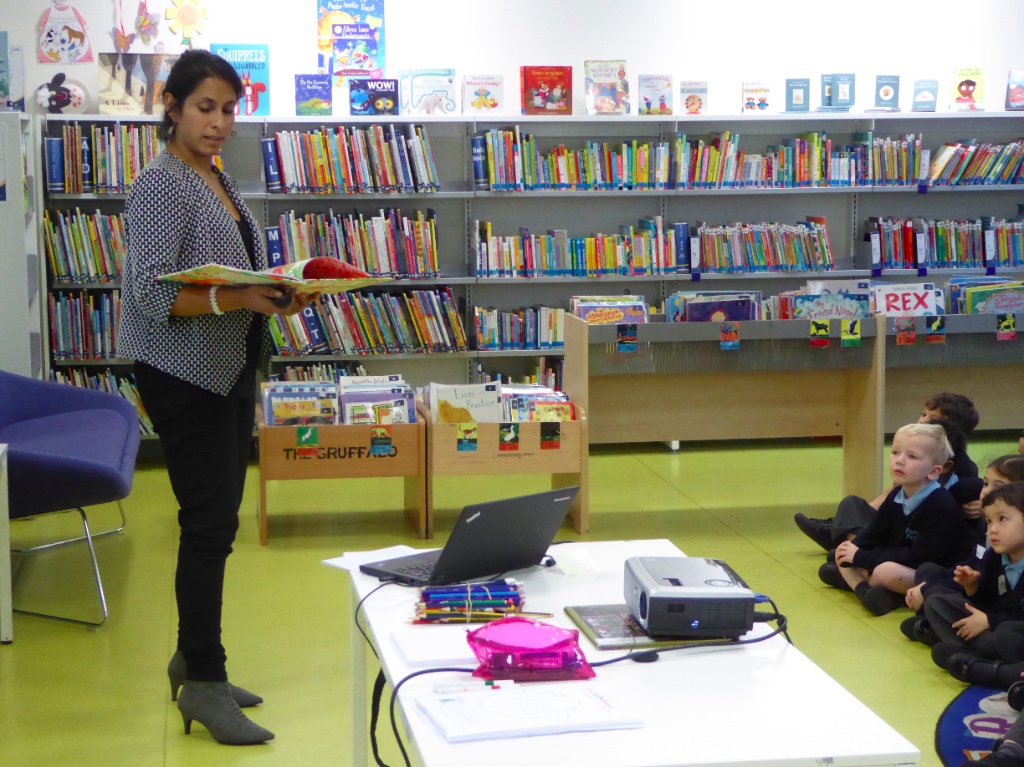Inclusive collections for supercharged storytimes

at Pimlico Library, via Libraries Team on Flickr,
CC BY 2.0 DEED
Storytimes can be transformative for children, offering them the chance to imagine possible futures for themselves. This begins with the stories you include. Look around your community and consider which books in your collection reflect the experiences of the families you serve. Do the children who come to your storytime see themselves in the books you select? How might you include stories that enable children to learn about experiences other than their own?
Curating a diverse collection
It’s important to be intentional when selecting books for your storytime program, and we’re here to provide some inspiration. This collection of diverse booklists can help inform your storytime choices and ensure that the children who come to your storytimes experience a sense of belonging and broaden their worldview.
Selection tools
- American Indians in Children’s Literature: “A critical resource of Indigenous peoples in children’s and young adult books”
- Booktoss: A blog that highlights disability representation in children’s literature
- Brown Bookshelf: “Designed to push awareness of the myriad Black voices writing for young readers”
- ¡Colorín colorado!: “A bilingual site for educators and families of English language learners”
- The Conscious Kid: This website offers a variety of curated booklists, including “Children’s books by Latinx authors,” “Rosh Hashanah Children’s Books,” and “Children’s Books by AAPI Authors.”
- DeColores: The Raza Experiences in Books for Children: “Reviews and critiques children’s and young adult books about Raza peoples throughout the Diaspora.”
- Disability in Kidlit: “Dedicated to discussing the portrayal of disability in middle grade and young adult literature”
- Diverse BookFinder: “[A] comprehensive collection of children’s picture books featuring Black and Indigenous and People of Color (BIPOC)” See WebJunction webinar, Multicultural Picture Books: A Deeper Look at Your Collection, with a demonstration of how to use the Diverse BookFinder Collection Analysis Tool to help you diversify your picture book collection.
- Diversity: A WorldCat.org booklist
- Hijabi Librarians: “We review children’s and young adult literature that feature Muslim characters and communities.”
- Latinxs in Kid Lit: “Exploring the world of Latinx YA, MG, and children’s literature”
- Medal on My Mind: A Stonewall Speculation Blog:“A mock award blog speculating the potential results of the Stonewall Book Award”
- Mirrors Windows Doors: “An online magazine whose aim is to draw attention to the riches of children’s and YA books from across the world that highlight cultural and multicultural diversity.”
- A Novel Mind: “A resource for exploring children’s literature that deals with mental health and neurodiversity issues”
- Queer Book List: “An accessible resource that anyone can use to learn about [queer novels] and get recommendations…a resource guide for educators and students alike.”
- Reading (AS)(I)AN (Am)erica: “Book reviews with an Asian Americanist lens”
- Reading While White: “Working for racial diversity and inclusion in books for children and teens”
- Rich in Color: “Reading & Reviewing Diverse YA Books”
- Reading Spark: “Musings on Korean diaspora, children’s literature, and adoption”
- The Pirate Tree: “Social Justice and Children’s Literature”
- Twinja Book Reviews: “Fighting to bring Multiculturalism to YA Fantasy and Science Fiction Novels”
- We Are Kid Lit Collective: “We look for ways to improve the literacies of BIPOC children, promote books written by and about BIPOC, and to encourage gatekeepers to bring a lens of critical literacy to their work.”
Recommendations for implementing inclusive programs
- Let's Talk About Race in Storytimes: This webinar recording from Washington State Library offers strategies for creating inclusive storytime programs—presented by Jessica Anne Bratt, Grand Rapids Public Library.
- Diversifying Classroom Texts: This webinar from Learning for Justice offers best practices for selecting and using diverse texts that are relevant for children’s and youth librarians as well who are seeking to center Black and Brown voices in their programming.
Background on diversity in children’s literature
- Minorities in Publishing: “A podcast discussing diversity (or the lack thereof) in the book publishing industry.”
- Mirrors, Windows, and Sliding Glass Doors: Foundational article written by Dr. Rudine Sims Bishop that explains why representation in children’s literature matters, not just to reflect lived experiences but also to expand and provide insight into new experiences.
WebJunction resources
- Conscious Child Family Book Discussion Kits on Racial Equity, Identity, and Justice: Learn about these popular book discussion kits in this interview with Caitlin Campbell, Children's Librarian at the Oxford Lane Library.
- Doing the Work Externally and Internally: Race, Equity, Diversity and Inclusion: This webinar recording highlights the work of Richland Library staff as they work, both externally and internally, to improve dialogue and understanding on topics of race, equity, diversity and inclusion. See the webinar page for a list of even more resources, including Richland Library’s list, Diverse Books for Families Booklist (doc)
- Multicultural Picture Books: A Deeper Look at Your Collection: This webinar recording offers a demonstration of how to use the Diverse BookFinder Collection Analysis Tool (CAT) to help you diversify your picture book collection. Or check out this article that gives an overview of the tool: Multicultural Picture Books: A Deeper Look at Your Collection.
This content is also available in a Word document.
For more storytime resources and strategies, check out our newly updated Supercharged Storytimes course, which is available anytime in the WebJunction Course Catalog.
